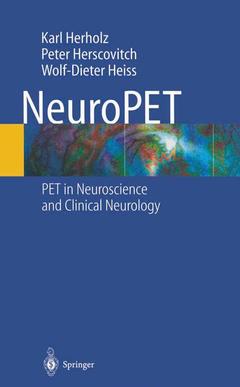NeuroPET, Softcover reprint of the original 1st ed. 2004 Positron Emission Tomography in Neuroscience and Clinical Neurology
Langue : Anglais
Auteurs : Herholz K., Herscovitch P., Heiss W.-D.

Positron emission tomography (PET) provides unbiased in vivo measurement of local tracer activity at very high sensitivity. This is a unique property unmatched by other imaging modalities. When PETwas introduced into medicine more than 25years ago, the first organ of major interest was the brain. Since then, PET has flourished as an extremely powerful and versatile tool in scientific brain studies, whereas its use as a diagnostic tool in clinical neurology remains limited. This is in contrast to its use in otherapplications,particularlyoncology,where its value in clinical diagnosis is more widely appreciated. Wethink this situation is unfortu nate, because PET can contribute more to clinical neurology and clinical neuro science than is generally perceived today. Realization of its potential will require very close cooperation between PETexperts and clinicians and the integration of PET into clinical studies. Thus, in this book we review PETin neuroscience,with particular emphasis on findings that indicate its potential for improving diagno sis and treatment in neurology and psychiatry. We want to improve the trans ferability of the enormous scientific advances in brain PET into clinical care so as to produce tangible human benefit [1]. Wewish to guide both nuclear medicine specialists and also neurologists and psychiatrists in the use of PET. We there fore focus on practical and potentially clinically relevant issues, identifying solid ground as well as open questions that require further research, and we see this targeted presentation as complementary to more general PET textbooks and reviews.
1 Introduction.- 2 Clinical Studies.- 2.1 Dementia and Memory Disorders.- 2.2 Movement Disorders.- 2.3 Brain Tumors.- 2.4 Cerebrovascular Disease.- 2.5 Epilepsy.- 2.6 Other Neurological Disorders.- 2.7 Psychiatric Disorders.- 3 Imaging Brain Function.- 3.1 Blood-Brain Barrier Transfer.- 3.2 Cerebral Blood Flow.- 3.3 Oxygen Consumption.- 3.4 Glucose Consumption.- 3.5 Influence of Brain Function on CBF and Metabolism.- 3.6 Tissue Oxygen Pressureand pH.- 3.7 Amino Acid Transport and Protein Synthesis.- 3.8 Nucleosides and DNA Synthesis.- 3.9 Molecular Imaging.- 3.10 Dopamine System.- 3.11 Cholinergic System.- 3.12 Serotonin System.- 3.13 Gamma-aminobutyric acid (GABA).- 3.14 Glutamate and NMDA Receptors.- 3.15 Adenosine Receptors.- 3.16 Histamine Receptors.- 3.17 Cannabinoid Receptors.- 3.18 Opioid Receptors and Sigma Receptor.- 3.19 Steroid Receptors.- 3.20 Substance P.- 3.21 Secondary Neurotransmitters.- 4 Data Acquisition, Reconstruction, Modeling, Statistics.- 4.1 Positron Emitters and Tracers.- 4.2 Scanners and Detector Systems.- 4.3 Data Acquisition.- 4.4 Image Reconstruction.- 4.5 Motion Detection and Correction.- 4.6 Data Visualization.- 4.7 Image Coregistration.- 4.8 Anatomical Standardization.- 4.9 Physiological Modeling.- 4.10 Quantitative Data Analysis.- References.
Includes supplementary material: sn.pub/extras
Date de parution : 11-2013
Ouvrage de 297 p.
15.5x23.5 cm
Date de parution : 09-2004
Ouvrage de 300 p.
Thèmes de NeuroPET :
© 2024 LAVOISIER S.A.S.



